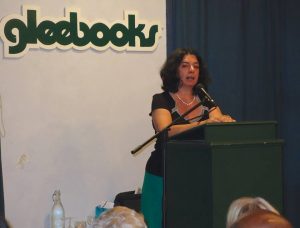Should You Have More Than One Bio? YES. Here’s Why…
By Sophie Masson | April 25, 2017 |
 Sometimes the shortest things can unexpectedly be the hardest to write. And that’s the case with author biographies, or bios for short. Bios aren’t like CVs. They’re not as formal. They are more like mini-stories. They give a flavour of the person behind them. And like query letters and blurbs, they function as ‘hooks.’
Sometimes the shortest things can unexpectedly be the hardest to write. And that’s the case with author biographies, or bios for short. Bios aren’t like CVs. They’re not as formal. They are more like mini-stories. They give a flavour of the person behind them. And like query letters and blurbs, they function as ‘hooks.’
Over the course of a writing career, you’ll discover you need more than one bio. In fact, you might find that you need quite a few. Each of them will be written for particular purposes, whether that be pitching for genre-specific projects, for festivals and conferences, or for book proposals and blurbs. Each of them will have a slightly different angle, though they encapsulate the same basic biographical and bibliographical information. And though they may fall into ‘types’ of bios—ie, for publication, presentation or industry purposes—each bio is also slightly different, even within each type.
The Case of Valerie May
For a bit of fun, let’s take the (imaginary) case of Valerie May, author of romantic suspense novels who also writes the occasional non-fiction authorship book. Here are a couple of her pitch bios, one for a non-fiction book called Roses have Thorns, a practical guide to maintaining a writing career, and the other for her new novel, The Jade Peacock.
Bio A: Valerie May is the award-winning author of fifteen novels, including the internationally bestselling The Black Rose. She is the founder of Delicious Shivers, a popular blog specialising in the romantic suspense genre, and with fellow author Jenna Sims initiated the first Delicious Shivers seminar, now an annual event. Over the course of her career, Valerie May has been a bookseller, served on several literary industry committees, and been a popular speaker at conferences and festivals.
Bio B: Born in London of an Irish father and French-Vietnamese mother, Valerie May was brought up between languages and cultures and now lives in Sydney, Australia, with her family. The award-winning author of fifteen novels of romantic suspense, including the bestseller The Black Rose and its popular sequel, By Any Other Name, as well as three works of non-fiction, she also blogs regularly, and features as a speaker at literary events. Her Vietnamese grandmother’s dramatic story was the inspiration for The Jade Peacock.
These two bios have a similar structure, but a different emphasis, with each aimed at establishing Valerie’s credentials in a particular context . For Roses have Thorns, the emphasis is on Valerie’s professional experience in the book industry; but for The Jade Peacock, the bio takes in not only her track record as a writer, but also a great deal more personal information, including her cultural background which is relevant in this case. In both, the fact that she is a successful professional author is front and centre, but in the novel bio, there is a more private angle as well, allowing the reader to relate to the author as a person. Meanwhile, for the non-fiction book, her experience of the industry from different professional points of view–author, blogger and bookseller–is highlighted, and more personal information is omitted.
By the way, it’s my opinion that it’s best to write bios in third person, and to stay away from quirky bios. I mean the kind that tell you the author has a pet python, likes drinking wine while waltzing in the rain, never met a vampire they didn’t like—or whatever other random detail might come to mind! They are really hard to pull off successfully outside of social media, and often just sound try-hard or out of place. What works for Twitter or Facebook doesn’t usually translate well to the pitching environment.
 That also goes for bios for school and festival presentations–unless you are pitching to present at a comedy festival, in which case your quirky bio had better be actually entertaining, not just groan-inducing!
That also goes for bios for school and festival presentations–unless you are pitching to present at a comedy festival, in which case your quirky bio had better be actually entertaining, not just groan-inducing!
A brief note here on bios as part of a pitch for conferences, festivals, seminars and other public speaking events. Of course, you know that you need to target your pitch to the particular type and theme of the event, the expected audience, and your particular suitability as a presenter. So my advice is this: Do your research, and craft your bio so that they will be falling over themselves to offer you the gig.
Over to you: What challenges and pleasures have you encountered in crafting bios? And what’s your view on the quirky bio?









I don’t have two bios, so your post today is quite refreshing. Because I have mostly supernatural fiction published (novels and short stories, and similar content for my blog) I tend to pitch my bio with that lead. I like the personal touch of bio B.
As a pre-pubbed author, my bios are on Twitter and Facebook, and fall into the boring or quirky categories. After reading this, I see the need to work up a more professional bio.
Insightful post. One I’ll bet many new authors have not been aware of…until they are required to send in short bios to different media outlets. Having ghostwritten a medical memoir with a rags-to-riches immigration background story, I learned the necessity of tweaking a short bio for different pitches–for bookstore talks and author events, publicity and promotional materials. A lot of crafting goes into such a small final product. Thanks for the skillful examples.
Great advice!
Also, be sure to update every single bio you have from time to time. I just re-read my author bio on Amazon and it had some outdated info. And that includes photos. I no longer look like the gal who started writing nearly twenty years ago, that’s for sure. Revamping is also a great time to add new books, awards, and so on. A great way to remind us writers that we are still writing. It’s a nice pat on the back!
Excellent point, Leslie!
I think quirky a bio can work, if it’s consistent with the tone of the work and appropriate for the audience. What a writing conference attendee wants to see is different from what a potential MG fantasy reader wants to see, which is different still from what a potential adult thriller reader wants to see.
Part of the reason people might grasp at wine and vampires is that they don’t feel they have anything else to say. I personally have no writing credentials or publishing history whatsoever, so my charming quirks are all I have to recommend me!
Good stuff, Sophie.
One thing I’ve also found helpful is to craft multiple versions of my bio in different lengths.
For different events or publications, it’s not uncommon to get asked for “a 50-word bio” or “a 100-word bio,” so I recommend having at least a couple of versions in different sizes ready to go.
I have bios of different lengths. Sometimes an organization only wants fifty words; sometimes you are given more leeway. I review them all each time I’m asked for one.
Very interesting post. The need of multiple bios is very much clear from your post. I’ll also craft my bios according to their publishing platforms. Thanks for sharing this kind of knowledge.